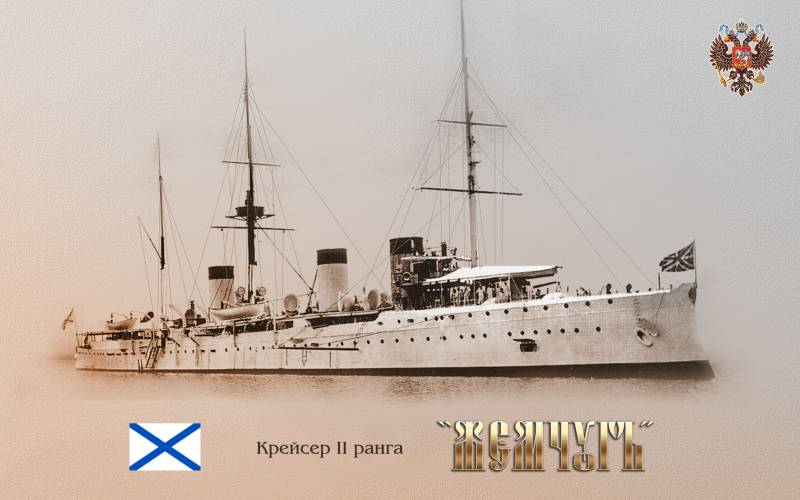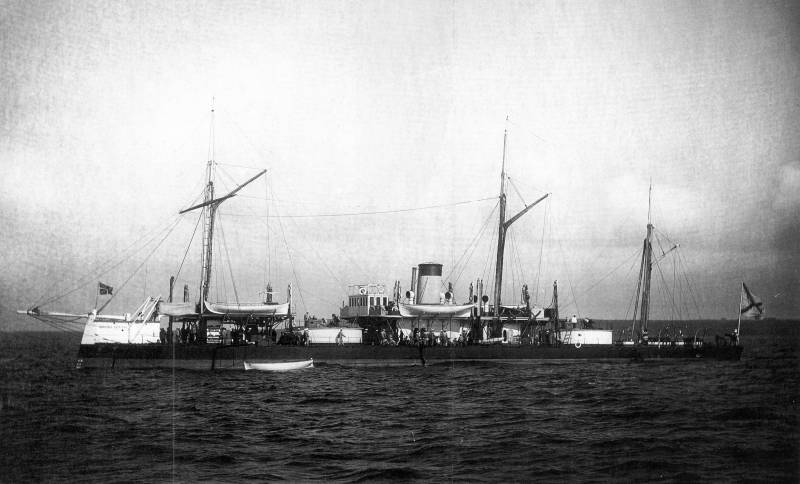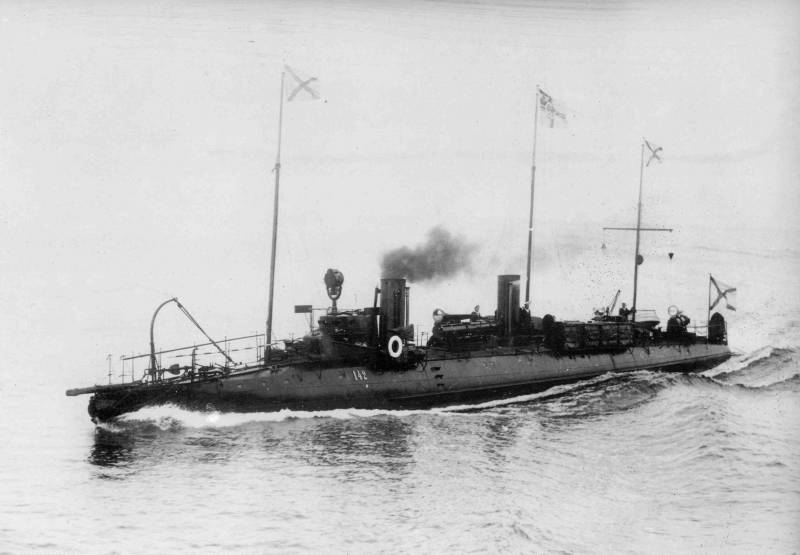Jewels of the Russian Imperial Navy. "Pearls" and "Emerald"
Both cruisers were built by Nevsky Zavod, and in order to better understand the vicissitudes of their creation, you should refresh your memory. history this industrial enterprise.
The Nevsky Plant grew out of a small iron foundry, created sometime in the middle of the 19 century by an Englishman by the name of Thomson, but it was also involved in the manufacture of cast iron cores. In 1857, this small for that time production was bought by Major General P.F. Semyannikov and lieutenant colonel V.A. Poetry, which, apparently, tied friendships with the Mining Institute, in which they were fellow practitioners. Their acquisition was named “Nevsky Foundry and Mechanical Plant of Semyannikov and Poletika” (often referred to simply as “Semyannikovsky Plant”) and began immediate prosperity: almost immediately began construction of two small steamboats, the plant began to expand, erecting new production facilities.
Certainly P.F. Semyannikov and V.A. Flight had a commercial vein: the fact is that in the 60s of the 19th century, Russia began the construction of a steam armored fleet, and here the new plant came in handy. The period of the 60s of that century turned into a real shipbuilding boom for the Nevsky Plant: the Kremlin armored battery, the Perun and Lava monitors, the armored frigates Admiral Chichagov and Admiral Spiridov, as well as Minin were built at its shipyards ".
But in the next decade, orders dropped sharply: however, an armored frigate “General-Admiral” was laid out in 1870, but then a considerable break came. Later, from more or less large warships, the Herald and Rogue clippers were started, but this happened only in 1877-78. And the Nevsky Zavod did not receive any orders for ships larger than destroyers before the end of the century.
There were two reasons for this: scientific and technical progress and the unfortunate location of the plant. He stood on the Neva River, and at that time its bridges, although already adjustable, did not allow ships to pass over 8 000 with a displacement. At the same time, warships grew very quickly in size, so the Nevsky Plant could not build modern armadillos and ocean cruisers. However, the plant did not die from this and did not become decaying, but was redeveloped to build steam locomotives, of which more than 1899 1 units were built by 600. However, military and civil shipbuilding was also not forgotten - the plant built large series of destroyers, as well as steam engines and boilers.
During this time, the plant changed owners twice - first, it passed to the Russian Society of Mechanical and Mining Plants, and then, in 1899, it was bought by the partnership of the Nevsky Shipbuilding and Mechanical Plants.
How well did the warships build the Nevsky Plant? To answer this question is very difficult. At the dawn of its “naval career,” the rate of construction was not too different from other enterprises of the same profile. For example, the Perun and Lava monitors were built in 2 of the year and 2 months, while other plants (Carr and MacPherson, New Admiralty) coped with the same type of ships in 1 year 11 months. - 2 of the year 1 mon. However, the Belgian shipyard managed for 1 a year and 8 months. But the Minin armored frigate plant managed to build as many 13 years: however, in fairness, we note that it was more the fault of the admirals who first wanted to get a casemate battleship, then also a battleship, but a tower one, and after the tragic death of the British Captain for a long time they wanted different things, but eventually they returned to the casemate pattern. As for quality, it also happened here in different ways. So, for example, the Nevsky Zavod quite successfully coped with the construction of the hull of an armored frigate “General-Admiral”, the weight of which was only 30% of its displacement, but was also very durable. For comparison, the hull of the English cruiser Inconstant had a weight in 50% of the ship’s displacement. However, the story also kept the verdict of the ITC, made by him during the construction:
As for the construction of the destroyers, with them, too, everything did not go very smoothly. The first large series of ships of this class, built by the Nevsky Zavod, consisted of 10 number destroyers of the Pernov type with a displacement of 120-130 (No. 133-142), unfortunately, did not differ in the quality of construction, and were significantly inferior in TTH of the prototype built in France.
But I must say that the destroyers of this type were also ordered to other domestic shipbuilding enterprises, and not a single Russian plant managed to build them. In the future, 5 of the Cyclone type destroyers with a displacement of 150 tons were built at the Nevsky Plant; however, according to the Marine Ministry, the company coped with this order very badly. It’s so bad that they didn’t want to give the next order for destroyers: but alas, there wasn’t much choice, and the plant’s management did everything possible to assure the customer that this time everything would be done at the highest technical level and right on time. An inspection was carried out, representatives of the GUKiS arrived at the Nevsky Zavod, and they found that the general technical level of shipyards and workshops would allow the plant to fulfill its promises.
As a result, the Nevsky Plant ordered 13 destroyers of the Sokol type with a displacement of 240 tons. One of them was the famous Steregushchy. However, the construction program of this series Nevsky Plant also failed miserably. So, from 13 the destroyers 4 were intended for the Baltic Sea and, according to the signed contract, they should have been submitted for state tests in 1899. However, in fact, they were able to be presented for acceptance tests only in 1901 year. As a result, the head “Prudent”, incorporated in 1898 g, was commissioned only in 1902! In England, some battleships were built faster. Perhaps, only the fact that the destroyers of this type, as a rule, even exceeded the contract speed of 26,5 knots, speaks in favor of the Nevsky Zavod. Many of them developed 27-27,5 knots on tests.
And so it happened that the plant, which in the 60 of the 19 of the century was at the forefront of technological progress and created the strongest ships of the Russian Imperial Navy, by the end of the century with great difficulty coping with the construction of destroyers with a displacement of 120-258 tons. And, nevertheless, already largely losing the skills of military shipbuilding, the Nevsky Zavod took part in 1898 in the competition for the creation of the high-speed armored cruiser 2. Having fairly estimated our own forces (more precisely, their almost complete absence), the Nevsky Plant resorted to foreign aid: the corps was designed by the English engineer E. Reed, the mechanical part was designed by Maudsley, Field and Sons.
The resulting project on paper was very interesting. Its length was 117,4 m, exceeding that of Novik (unfortunately, it is not clear how much, because it is not clear whether it is a question of length between perpendiculars, or maximum, etc.) with a similar width of 12,2 m. The cruiser was very strong reservation, the thickness of the bevel of the armor deck was supposed to reach 80 mm, conning tower - to 102 mm. The power plant was to consist of 2 steam engines and 16 boilers of the Yarrow type, the speed had to be 25 nodes. The deck was covered with tick, not linoleum, and the armament corresponded to the technical task (6 * 120-mm and 6 * 47-mm with one Baranovsky assault rifle), with the exception of mine apparatus, the number of which was reduced from 6 to 4. At the same time, the management of the Nevsky Plant turned to Vice-Admiral P.P. Tyrtov with a request to issue an order for 2 armored cruisers to the plant, in fact, out of competition. So to say, to support domestic producers.
What is interesting - the Marine Ministry was, in general, not against it, especially since Nevsky Zavod promised to modernize its production, and the joint “Nevo-English” project took the 3 place in the competition and was, in general, wrong at first glance so bad Thus, it could well turn out that the Russian Imperial fleet would be supplemented with armored cruisers of the 2 rank of three different projects (Novik, Boyarin and the project of the Nevsky Plant). But, apparently, the original merits of the joint “Anglo-Nevsky” creativity turned out to be “bought” at a too expensive price: one and a half years of fine-tuning the project did not lead to success, the cruiser still did not meet the requirements of the ITC. And so, January 8 1900 P.P. Tyrtov gives an order: “due to the impossibility to postpone further the construction of a cruiser in 3000 t at the Nevsky Plant ... to discuss and report on whether it will be possible to build a hull according to the drawings of the Novik cruiser, and the mechanisms and boilers - either according to“ Schihau ”or approved by MTC drawings of the plant Model, Field and Sons.
The MTC nevertheless assembled a committee to review the project of E. Reed and the Nevsky Plant for the last time, but found it unsatisfactory, and, as a result, it was decided to build the Shikhau cruiser. It would seem that there are all possibilities for this, because Novik’s working drawings should have been available. Indeed, in the construction contract concluded with the firm "Schihau", it was explicitly written: "the company must supply the observing engineers against receipt with a set of documentation and drawings. In addition, the company must provide to MTC a set of drawings in triplicate. ”
Alas, the story with the Varyag cruiser was repeated here - it turned out that the Russian text of the contract did not at all correspond to its German copy, while, as can be understood from the context, the Russian text was considered to be the main one. And the leadership of the GUKiS was surprised to find that the Germans did not at all consider themselves obliged to transfer working drawings to the Russians. Moreover, when representatives of the Maritime Ministry tried to discuss the conditions for the transfer of such drawings, Shihau refused to do so even for a fee. In general, the management of the German company notified our authorities that it was ready to transfer documentation only a few months after Russia ordered a second Novik cruiser or the equivalent number of destroyers.
As a result of various disputes, and the participation of Lieutenant Polis, acting in Germany as a marine agent of Russia, the price of working drawings was “knocked off” before ordering machines alone for the next Novik type cruiser.
In parallel with this, the specialists of the Marine Ministry had to fight the appetites of the Nevsky Plant. He was ready to take on the construction of two cruisers, with the construction of the first months in 28, and the second - 36 months, but with the condition that the countdown will begin only after the last drawing is transferred to the factory. GUKiS rightly saw this as an opportunity for the Nevsky Plant to delay the deadline for the delivery of ships due to any trifle, and did not agree with this condition.
Then bargaining began on the price of construction. Nevsky Zavod reported on its readiness to build two cruisers with a displacement of 3 200 t at a price of 3 300 000 rub. each. It was a very expensive proposal, because it was about building the ship itself, with armor, but without artillery and ammunition. “Novik” in a similar configuration cost 2 900 000 rubles, and the “Boyarin” being built in Denmark - 314 000 British pounds. Unfortunately, the author doesn’t know exactly the rate used to convert pounds into rubles, but based on the known total cost of the cruiser and the cost of its weapons and ammunition, it turns out that the cost of building it without them was 3 029 302 rubles.
Against this background, the 3,3 million rubles requested by the Nevsky Plant looked like a bad joke, so in response, the Maritime Department also decided to "joke." His representatives proposed to reduce the cost of each cruiser to 2 707 942 rub. Thus, the cost of two cruisers should have been reduced by 1 184 116 rub. Of which 100 000 rub. were deducted for ready-made drawings that the plant did not need to do, 481 416 rub. - for the removal of responsibility for failure to achieve the contractual progress of 25 nodes and another 602 700 rub. represented a discount for the order at once two cruisers.
It is obvious that the response “joke” of the Marine Ministry brought the appetites of the Nevsky Plant in line with reality, so their next proposal looked more or less reasonable - 3 095 000 rub. for the cruiser, though they asked for another 75 000 rub. from above for inviting engineers to supervise the construction. This is somewhat more than the Naval Ministry paid for Novik or Boyarin, but still within reason.
Meanwhile, Schihau continued to bargain for Novik’s working drawings. I must say that the copying of the drawings still had a place to be, because the German shipbuilders were obliged to coordinate them with the MTC. So, after it became clear that Schikhau was not going to provide these drawings, as it was written in the Russian version of the contract, all documents submitted for approval began to be duplicated, and, as far as can be understood, no one informed the Germans about it. But they themselves realized that by continuing to submit the drawings for approval, they risk losing profit, and therefore completely refused to provide them under the existing contract. At the same time, if at some point the Germans showed willingness to transfer them in the case of a contract for cars for one cruiser, now their appetites have increased again to “vehicle sets” for two ships, for which they also demanded 25% prepayment.
However, the spit found on the stone. The fact is that just at this time the junior shipbuilder Pushchin 1, who had previously been dismissed from his post, was returning to Russia ... apparently, “by forgetfulness” he took with him a set of drawings that he received from “Schihau” for temporary use. And it is very likely that as soon as these drawings came to the specialists of the Nevsky Plant, the management of the latter publicly announced the inadmissibility of the proposal of the German shipbuilders: “Transferring the order of machines abroad contradicts national interests - the development of national shipbuilding.” And the leadership of the Maritime Department fully supported the "domestic producer", with the result that the "Shihau" proposal was rejected. The Germans, realizing that they had miscalculated something, tried to offer only 2 machines at the most reasonable price and without any prepayment, but this deal was rejected.
On the one hand, the act of Puschina can with good reason be qualified as banal theft. But, if to argue in this vein, then the discrepancies in the texts of the contract for the construction of Novik should be recognized as a fraud by the German side. As far as can be judged, the ITC did not know in advance about the actions of Puschina. It is possible that he received an offer from the Nevsky Plant, although it is possible that this could be his private initiative. Of course, the drawings were eventually returned to the Germans, but only after they stayed in Russia for about a month. It can be assumed that in this case the turnaround of Germanic and Russian private producers collided, with domestic ones ... hmm ... Jeffa Peters got the upper hand from the economy. In any case, only one thing is reliably known - such “obscene” behavior of the junior shipbuilder did not affect his future career and did not prevent him, in due course, from reaching the rank of general.
So the detective story came to an end, and things went on as usual. In March, 1901 g made the final decision to order the Nevsky 2 cruiser plant, and 22 of September of the same year the board of the Nevsky Shipbuilding and Mechanical Plant Partnership, in accordance with the XUUMX XYNUMX order of April 7, No. 1900, signed a contract to build two cruisers of the type "Novik".
To be continued!



Information